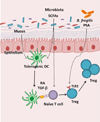T cells and intestinal commensal bacteria--ignorance, rejection, and acceptance
- PMID: 24997344
- PMCID: PMC4254331
- DOI: 10.1016/j.febslet.2014.06.040
T cells and intestinal commensal bacteria--ignorance, rejection, and acceptance
Abstract
Trillions of commensal bacteria cohabit our bodies to mutual benefit. In the past several years, it has become clear that the adaptive immune system is not ignorant of intestinal commensal bacteria, but is constantly interacting with them. For T cells, the response to commensal bacteria does not appear uniform, as certain commensal bacterial species appear to trigger effector T cells to reject and control them, whereas other species elicit Foxp3(+) regulatory T (Treg) cells to accept and be tolerant of them. Here, we review our current knowledge of T cell differentiation in response to commensal bacteria, and how this process leads to immune homeostasis in the intestine.
Keywords: Commensal; Effector cell; IgA; Inflammatory bowel disease; Intestine; Mucosa; T cell; Tolerance; Treg.
Copyright © 2014 Federation of European Biochemical Societies. Published by Elsevier B.V. All rights reserved.
Figures

Similar articles
-
Interaction Between Commensal Bacteria, Immune Response and the Intestinal Barrier in Inflammatory Bowel Disease.Front Immunol. 2021 Nov 11;12:761981. doi: 10.3389/fimmu.2021.761981. eCollection 2021. Front Immunol. 2021. PMID: 34858414 Free PMC article. Review.
-
Metabolites produced by commensal bacteria promote peripheral regulatory T-cell generation.Nature. 2013 Dec 19;504(7480):451-5. doi: 10.1038/nature12726. Epub 2013 Nov 13. Nature. 2013. PMID: 24226773 Free PMC article.
-
Adaptive immune education by gut microbiota antigens.Immunology. 2018 May;154(1):28-37. doi: 10.1111/imm.12896. Epub 2018 Feb 8. Immunology. 2018. PMID: 29338074 Free PMC article. Review.
-
Controlling the frontier: regulatory T-cells and intestinal homeostasis.Semin Immunol. 2013 Nov 30;25(5):352-7. doi: 10.1016/j.smim.2013.09.002. Epub 2013 Oct 31. Semin Immunol. 2013. PMID: 24184013 Review.
-
Regulation of intestinal homeostasis by innate and adaptive immunity.Int Immunol. 2012 Nov;24(11):673-80. doi: 10.1093/intimm/dxs094. Epub 2012 Sep 7. Int Immunol. 2012. PMID: 22962437 Review.
Cited by
-
The Microbiome, Timing, and Barrier Function in the Context of Allergic Disease.Immunity. 2016 Apr 19;44(4):728-38. doi: 10.1016/j.immuni.2016.02.002. Immunity. 2016. PMID: 27096316 Free PMC article. Review.
-
Spondyloarthritides: Theories and beyond.Front Pediatr. 2022 Dec 23;10:1074239. doi: 10.3389/fped.2022.1074239. eCollection 2022. Front Pediatr. 2022. PMID: 36619518 Free PMC article. Review.
-
Immunohistochemical distribution of FOXP3+ regulatory T cells in colorectal cancer patients.Int J Clin Exp Pathol. 2018 Apr 1;11(4):1841-1854. eCollection 2018. Int J Clin Exp Pathol. 2018. PMID: 31938291 Free PMC article.
-
Intergenerational Transfer of Persistent Bacterial Communities in Female Nile Tilapia.Front Microbiol. 2022 May 17;13:879990. doi: 10.3389/fmicb.2022.879990. eCollection 2022. Front Microbiol. 2022. PMID: 35655994 Free PMC article.
-
Proinflammatory cytokine interferon-γ and microbiome-derived metabolites dictate epigenetic switch between forkhead box protein 3 isoforms in coeliac disease.Clin Exp Immunol. 2017 Mar;187(3):490-506. doi: 10.1111/cei.12911. Epub 2017 Jan 12. Clin Exp Immunol. 2017. PMID: 27936497 Free PMC article.
References
Publication types
MeSH terms
Grants and funding
LinkOut - more resources
Full Text Sources
Other Literature Sources
Miscellaneous

